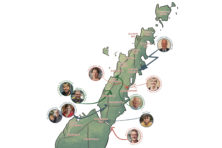Readers Weigh In on the Northern Door Line
- Share
- Tweet
- Pin
- Share
We asked. You answered.
Last week’s article that sought to figure out what “Northern Door” actually means generated a lot of responses by email and Facebook. Some were flippant, some crass, some funny. Many people put a lot of thought into their answer and submitted well-reasoned arguments for why they mentally put the line where they do.
For Kim Gilson, the volunteer coordinator for Door-Tran, the question comes down to one of services. She said she pulls out the county’s transportation-system map, which defines Carlsville and up as Northern, and County H and south as Southern.
“My answer is grounded in this map, as it determines what a person will pay to get into Sturgeon Bay to go to the hospital, do their big-box shopping at Walmart, get to one of the bigger grocery stores, or get to the county offices,” she explained. “Once you are tucked inside those lines of what Door 2 Door calls north and far south, you are where transportation is a completely different fare and is more easily accessible to county residents and tourists alike.”
Annie Miller’s answer was grounded in a childhood memory of sitting in the back of her family’s ’51 Ford for three hours while waiting in line for the ferry to cross Sturgeon Bay when a freighter hit the Michigan Street Bridge in 1960.
“To me, the dividing line is the canal,” she said. “All of us living on the north side of the span, or who had to cross daily for work, realized we were in Northern Door and were just as isolated as the folks on Washington Island when the ferry doesn’t run due to heavy storms and gale-force winds.”
Paula Kosin of Chicago gave a visual interpretation. Southern Door, she wrote, is agricultural and looks very different from the north, which she thinks of as north of the canal.
But other readers said the canal doesn’t quite work and put the line just north of the city, as Tom Siberz wrote.
“Being a 52-year visitor, I have always thought Sturgeon Bay would be the logical divider,” he wrote. “Sturgeon Bay is ‘the city’ and stands separately.”
Lyn Hale was one of a few readers who puts the line much farther north. Gills Rock and Ellison Bay are “villages that are north of the tension line,” she wrote. “Traveling down the west side of the peninsula, we hit the bustling towns of Sister Bay, Ephraim, Fish Creek and Egg Harbor. I don’t see these towns as having much in common with those north of them.” Ultimately, “It’s as much a philosophical question as it is a geographical one.”
Joshua Lardinois urged us to “just refer to Door County as Door County and quit with the contrived, forced divisions. There’s enough division in the world that it seems an exercise in futility to try to force another one into existence. Let’s appreciate the differences that all of Door County has to offer to the whole. The whole is greater than the sum of its parts.”
Karen Ansley saw it a little differently.
“For my family, the line was from Egg Harbor to Jacksonport and north,” she wrote. “We used it solely for orienteering and directions, as in, ‘Where in the world are we?’ It was never a judgment nor carried any sort of greater/lesser value.”
Paul Fitzgerald, in jest, suggested a line many far-northerners would probably agree with.
“Since we live in Gills Rock in the summer, I tend to think of Northern Door as north of the Al Johnson’s goat traffic jam” – but more seriously, as north of the bridges.
Terrie Cooper said she always saw it as defined by the Gibraltar School District line, from Egg Harbor over to Baileys Harbor.
And Tanna Lou shared a sentiment most agree on: “All of Door County is beautiful, and some of the most calm and amazing spots are in Southern Door,” she wrote. “Also, it’s the amazing people everywhere in Door County who make this the best place to live and raise a family.”

